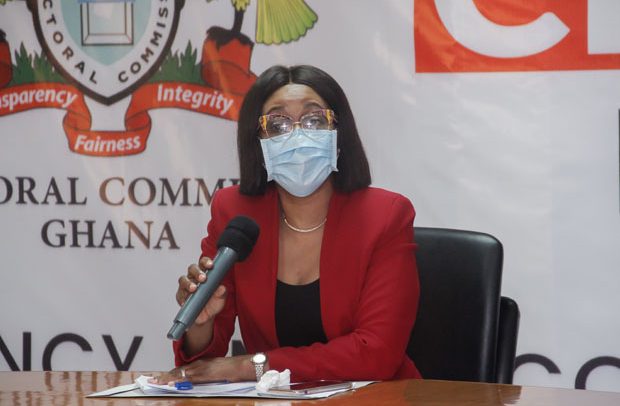Jean Mensa
First time registrants within the age brackets of 18 and 20 have made an impressive showing in the ongoing voter registration exercise.
This detail emerged last Monday when the Electoral Commission (EC) Chairperson, Jean Mensa, addressed the media as part of the ‘Let The Citizen Know’ series.
The statistics speaks volumes about the interest whipped up by persons within the age bracket who would be exercising their franchise for the first time.
It is instructive to note that most of them are students in their final year in senior high schools across the country – first batch of beneficiaries of the Free SHS programme.
According to the EC chairperson, “it is encouraging to note the enthusiasm of our youth generally; those within the 18-20 year bracket have participated actively in this exercise,” adding that “at the end of Phase Four, 480,851 18-year olds had registered as voters. This figure represents 4.1% of the register. Besides, 419,530 19-year olds had registered. In a nutshell, the 18 and 19-year olds make up 7.7% of the register.”
EC Initiative
But for the insistence by the EC that every eligible Ghanaian be allowed to register and, therefore, taking its kits to the SHSs where final year students are confined to enable them to take their final examinations, the opportunity would have slipped.
Women Over Men
Women, EC statistics indicates, have overshadowed their male counterpart in terms of the number of registrants.
In her presentation on the gender dynamics, the EC boss said, “We have seen more women registering in this exercise than men. Whilst this is not surprising, the gap is quite wide. To date we have a total of 6,100,440 as against 5,528,970 men who have registered. Women make up 52.5% of registered citizens so far compared to men who make up 47.5%.”
Inclusive Agenda
According to the EC, the registration exercise has been the most inclusive yet in the annals of voter registration in the country, and it is contrary to fears expressed by some politicians who did not agree with the whole exercise.
“This exercise has been inclusive and has attracted a good number of persons with disabilities. At the end of the fourth phase, 46,237 persons with disabilities had successfully gone through the registration process – this represents 0.40% of the total number registered. These figures are very encouraging, and this is an indication of the unwavering interest that citizens have in who manages the reigns of leadership (of our dear country),” she disclosed.
Citizenship Proof
The Ghana Card continues to lead as the proof of citizenship in the ongoing exercise and as the chairperson put it “out of the 11.6 million registered at the end of the Phase Four, 60.32% of citizens used Ghana Cards, 37.73% registered using guarantors and 1.95% registered with their passports.”
With regard to the Ghana Card, she revealed that “80% of the population in the Eastern Region presented the Ghana Card followed by the Oti Region where 78.4% of applicants presented the Ghana Card. The Western North Region came third, where 74% of applicants presented the Ghana Card. Regarding the use of guarantors, the Ahafo Region had the highest percentage of guarantors per population, with 57.5% of the population using guarantors followed by the Bono East Region where 56.8% of the population used guarantors, and the Bono Region where 56.6% of the population used guarantors.”
Total Registrants
A total of 12,371,651 people have as of Sunday, July 26, 2020 registered for their cards and the commissioner said the figure represented 82.5% of the expected target of 15 million.
She announced that at the end of the fourth phase, the Greater Accra Region had the highest number of registrants of 2,615,925 followed by the Ashanti Region with a total of 2,089,923 and the Eastern Region maintaining the third position with a total of 1,084,734.
“After this, we had the Central Region with 1,074,519 people, the Western Region with 734,545, the Northern with 687,123, the Volta Region with 660,508, the Bono Region with 460,226, the Upper East Region with 409,825, the Bono East Region with 391,777, the Western North with 300,015, the Upper West Region with 299,480, the Oti Region with 226,109, the Ahafo Region with 212,670, the Savannah Region with 195,126, and finally the North East Region with 186,975,” she added.
By A.R. Gomda

